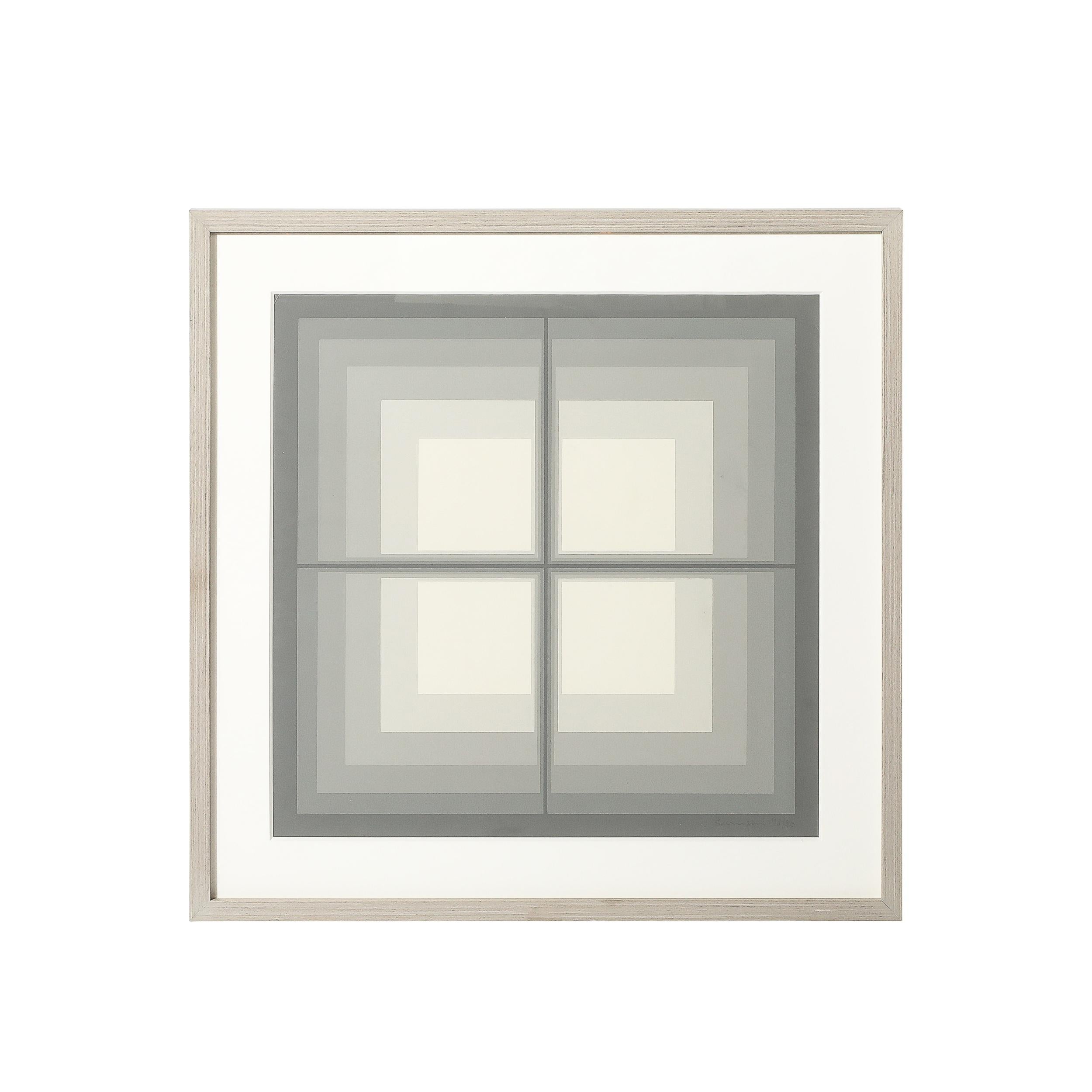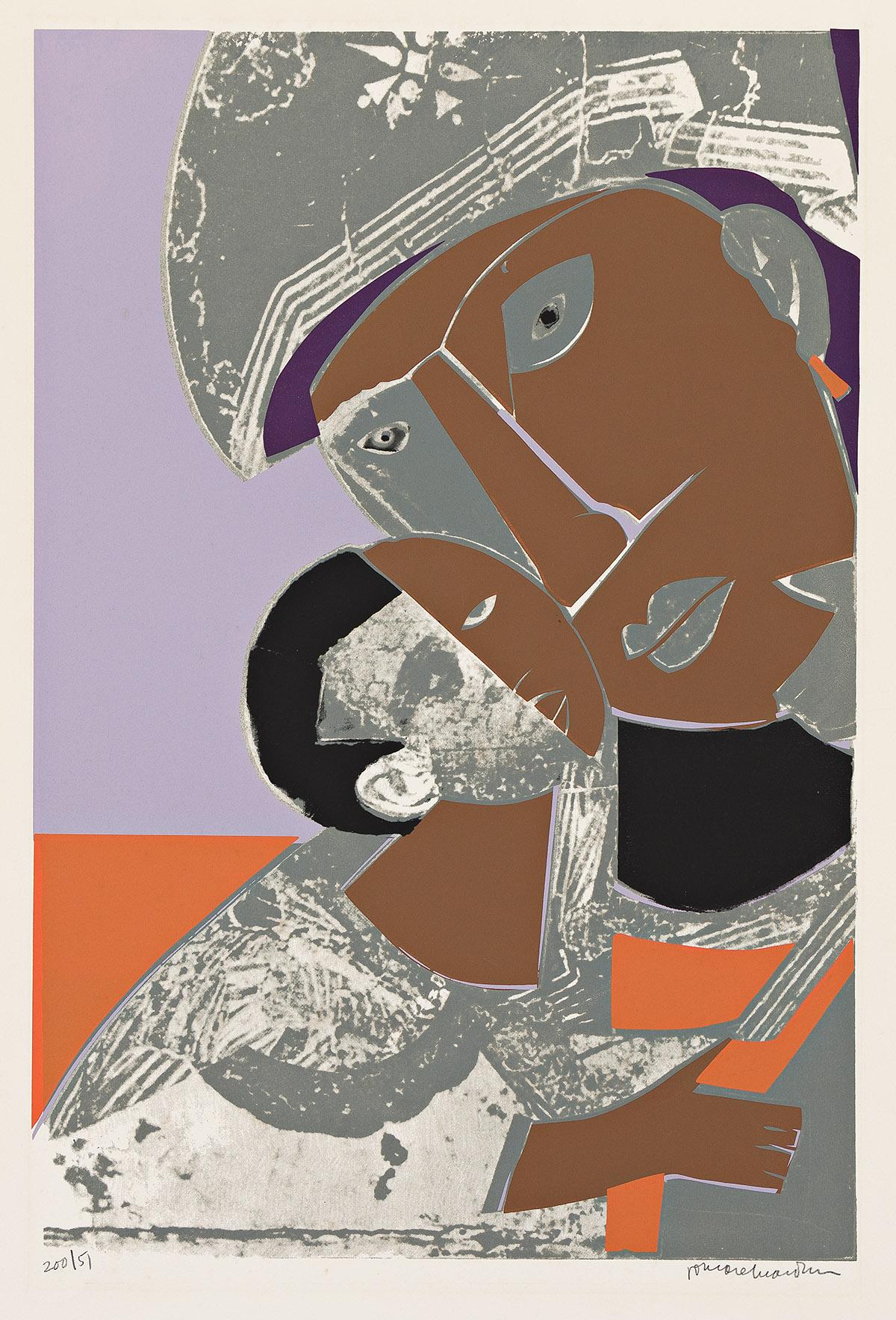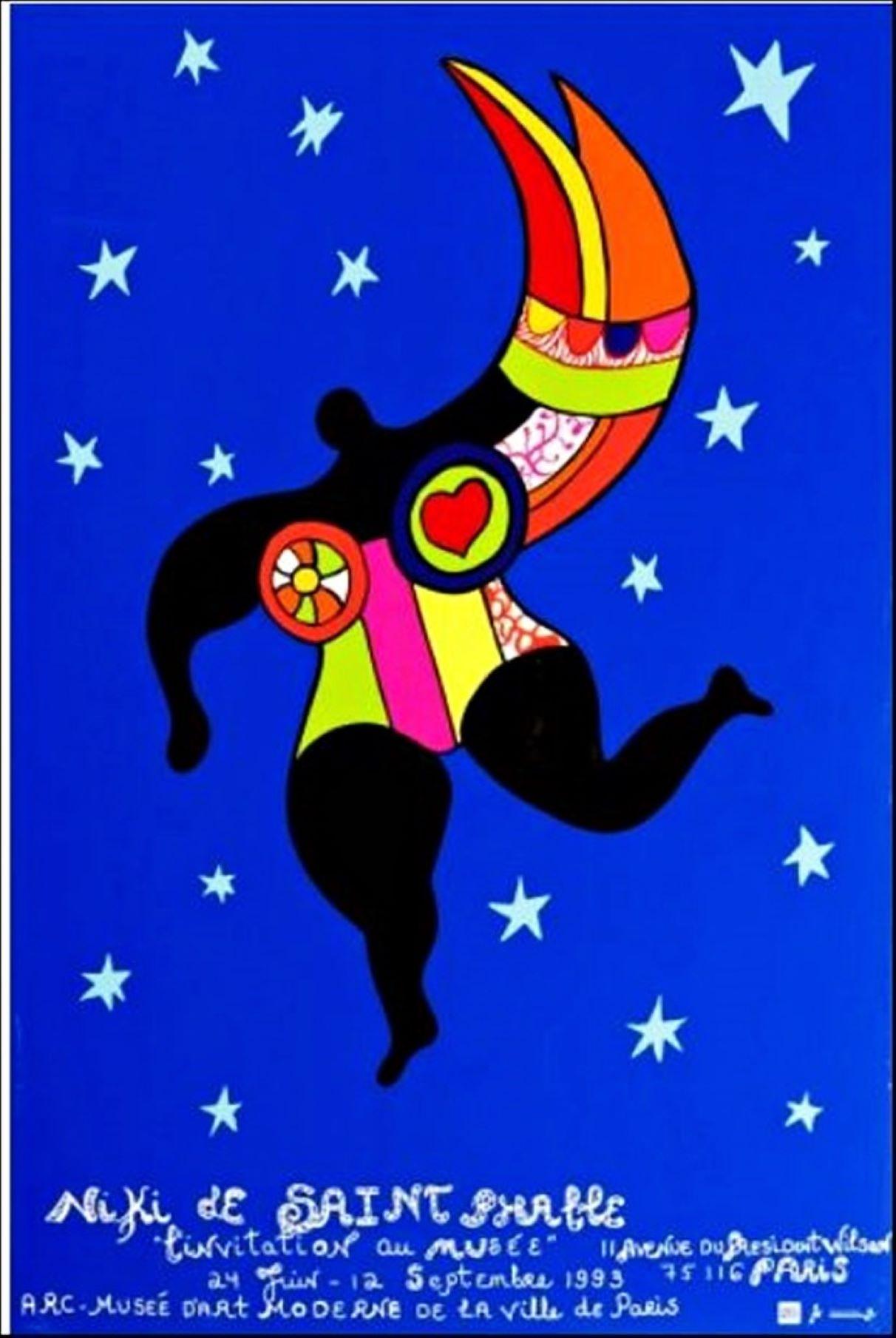Yaacov AgamSigned Yaacov Agam Silkscreen Printc. 1980
c. 1980
About the Item
- Creator:Yaacov Agam (1928, Israeli)
- Creation Year:c. 1980
- Dimensions:Height: 52 in (132.08 cm)Width: 29.125 in (73.98 cm)Depth: 1 in (2.54 cm)
- Medium:
- Movement & Style:
- Period:
- Condition:Not examined outside of the frame.
- Gallery Location:Larchmont, NY
- Reference Number:1stDibs: LU2211213378242
Yaacov Agam
Influenced by his upbringing in Judaism as well as the teachings of the Bauhaus, Yaacov Agam is a pioneer of kinetic art as well as the Op art movement and is often credited with introducing geometric abstraction to his home country of Israel.
Born in Rishon LeZion, Palestine — now part of Israel — the son of a rabbi, Agam found that the spiritual world had a major influence on his art practice, as did the sand dunes he grew up watching as they constantly shifted with the wind. This perpetual movement would inform his work, whereby riveting, prismatic compositions that transform from different perspectives, patterns that generate optical effects and sculptures that move with a passing breeze all reflect the gradual changes in nature.
Agam studied with Israeli painter Mordecai Ardon at the Bezalel School of Art in Jerusalem in the 1940s before traveling to Zurich where he trained with Swiss Expressionist painter Johannes Itten and was inspired by the abstract work of Russian painter Wassily Kandinsky.
One of the innovative techniques Agam developed was the Agamograph, which uses lenticular printing so that multiple images, which are revealed as the viewer moves around the piece, can be seen on a single work. His art has regularly involved the spectator as a participant, whether it’s the 1972–74 room-size kinetic installation he created for the Elysée Palace that’s now in the Centre Pompidou in which a gleaming abstract sculpture is surrounded on all sides by polychromatic lines or it’s public art like the 1986 Fire and Water Fountain in Tel Aviv with circles of vibrant panels that offer varying colors from every angle.
In 2018, the Yaacov Agam Museum of Art opened in Rishon LeZion, showcasing six decades of Agam’s influential work that engages with perception through color, shape and form, from paintings, prints and installations to new experiments in interactive digital art.
Find a collection of Yaacov Agam art today on 1stDibs.
- ShippingRetrieving quote...Ships From: West Babylon, NY
- Return PolicyA return for this item may be initiated within 14 days of delivery.
- Margot Lovejoy Serigraph in Acrylic CaseLocated in Larchmont, NYMargot Lovejoy (American, 1930-2019) Labyrinthe: City 3, c. 20th Century Serigraph in acrylic case Overall: 28 3/8 x 28 x 1 1/2 in. Artist Proof Signed lower right: Margot Lovejoy Si...Category
20th Century Contemporary Abstract Prints
MaterialsScreen
- Hand Colored Etching by WPA Artist Agnes Mills, 1982, UniqueLocated in Larchmont, NYAgnes Mills (American, 1915-2008) Guignol Intermezzo, 1982 Hand colored etching (UNIQUE) Sight: 13 3/4 x 11 1/4 in. Framed: 19 1/2 x 17 x 3/4 in. Titled lower right Inscribed "AP" bo...Category
1980s American Modern Figurative Prints
MaterialsEtching
- James Rosenquist Original Etching & Aquatint, 1979By James RosenquistLocated in Larchmont, NYJames Rosenquist (1933 - 2017) Swing Screen, 1979 Etching and aquatint (two state) Sight: 17 1/2 x 35 1/2 in. (image) Framed: 30 1/2 x 59 1/2 x 1 1/2 in. Edition 21/78 Inscribed, signed, numbered bottom James Rosenquist was born in 1933 at Grand Forks, North Dakota. His family moved to Minneapolis in 1944. In 1948, he began his studies of art at the Minneapolis Art Institute. In 1953, he continued his studies of painting at the University of Minnesota. In 1955 he had a scholarship to go to the Art Students' League, New York, where he met Robert Indiana. During this period, he painted small format abstract paintings and worked part-time as a driver. In 1957 he met Jasper Johns and Robert Rauschenberg. In 1959 he was at the same drawing class as Claes Oldenburg and was made "head painter" by the Artcraft Strauss Corporation. He married the textile designer Mary Lou Adams. During the election he produced the picture President Elect in which John F. Kennedy's face is combined in a kind of collage with sex and automobile imagery. His first one-man exhibition in the Green Gallery, in 1962, was sold out. In 1963 he worked on several sculptures, had a number of exhibitions at the Galerie Ileana Sonnabend, showed his work at the Dwan Gallery...Category
1970s Modern Abstract Prints
MaterialsEtching, Aquatint
- Leonard Baskin Beautiful Abstracted Figure Wood EngravingBy Leonard BaskinLocated in Larchmont, NYLeonard Baskin (1922-2000) Death of the Laureate, `1957 Wood Engraving Framed: 18 1/2 x 18 in. Signed and inscribed bottom: Death of the Laureate, Ed. 20, For Walter [Rosenblum], Leo...Category
1950s American Modern Abstract Prints
MaterialsEngraving
- Lithograph Made with String by Paula ClendeninLocated in Larchmont, NYPaula Clendenin (American, b. 1949) Untitled, 1983 Lithograph Sight: 30 x 22 1/2 in. Framed: 44 3/4 x 34 3/4 in. Numbered, titled, dated and signed bottom: 1/15 / "The Things That Matter" / 83 Artist Paula Clendenin was born June 22, 1949, in Cedar Grove, Kanawha County. She has earned national acclaim for her paintings: richly colored, textured shapes that merge West Virginia’s mountain...Category
1980s American Modern Abstract Prints
MaterialsLithograph
- 1969 Monoprint by H. Lawrence Hoffman, SignedLocated in Larchmont, NYH. Lawrence Hoffman (American, 1911-1977) Inhale Exhale, 1969 Monoprint Sight: 19 x 15 in. Framed: 27 1/2 x 23 1/4 x 3/4 in. Signed and dated lower right, title inscribed verso H. Lawrence Hoffman (23 October 1911 – 20 January 1977) was a commercial book jacket designer, illustrator,calligrapher and painter who worked in New York City. He illustrated book covers for over 25 publishing companies, including Alfred A Knopf, Pocket Books, Popular Library, Macmillan, Simon & Schuster, The Viking Press, and Random House. Over the course of his career, he illustrated over 600 book jacket covers. Hoffman graduated from the Rhode Island School of Design (RISD) in 1934 and then completed two years of post graduate study in Commercial Art from RISD. He moved to New York City with the $200 he was awarded for winning a competition to design a coin for the 1936 300 year Rhode Island Tercentennial. He began his career as an Art Director at the A.M. Sneider Advertising Company (1938–1941) and at Immerman Art Studios (1941–?). After leaving Immerman, he worked as a free-lance artist and book illustrator for the remainder of his career. He also taught illustration and lettering at The Cooper Union (1960-1967) and was a Professor of Art at C.W. Post University (1967–1976). Hoffman began his career doing drawings for the pulp magazine, "Thrilling Mystery Magazine...Category
1960s Abstract Expressionist Abstract Prints
MaterialsMonoprint
- Mon Levinson Modernist Abstract Geometric Screen Print in Grey SquaresBy Mon LevinsonLocated in New York, NYThis brilliantly precise and sophisticated Mid-Century Modernist Abstract Geometric Screen Print in Grey Squares Edition 78/90 is by Mon Levinson and originates from the United State...Category
1960s Modern Abstract Prints
MaterialsScreen
- Mother and ChildBy Romare BeardenLocated in New York, NYA very good impression of this color screenprint. Signed and numbered 200/15 in pencil by Bearden. Catalogue reference: Gelburd/Rosenberg GG#59Category
1970s Modern Figurative Prints
MaterialsColor, Screen
- Invitation au Musee, original museum posterBy Niki de Saint PhalleLocated in New York, NYNiki de Saint Phalle Invitation au Musee, original museum poster, 1993 Silkscreen on wove paper 16 × 24 inches Unframed (not signed) original p...Category
1990s Modern Figurative Prints
MaterialsScreen
- "Golden Haven" - Mid Century Modern Dual Panel Vertical SerigraphLocated in Soquel, CABeautiful modernist figurative abstract with birds, a large scale vertical dual panel original serigraph, "Golden Haven I, and "Golden Haven II", by Phil Paradise...Category
1960s Modern Figurative Prints
MaterialsCardboard, Paper, Screen
- Italian Artist Modern Silkscreen Eugenio CarmiBy Eugenio CarmiLocated in Surfside, FLEugenio Carmi is an Italian painter born in 1920 in Genoa. He studied in Turin in Felice Casorati’s studio. His experience as a graphic designer in the ‘50s, is decisive for his pictorial research, based on a rigorous geometrical structure and on a fine analysis of the perception of colors. He participated in the Venice Biennale in 1966. In 1967 he showed some electronic works in the Superlund exhibition organized by Pierre Restany in Lund, Sweden. In 1968, he introduced the “Carm-o-matic”, during the Cybernetic Serendipity show at the Institute of Contemporary Art in London. In 1973, he produced an entirely abstract 25-minute show for RAI’s Experimental Programs Service. The same year, he taught visual art seminars at the Rhode Island Institute of Design in the United States. In the ‘70s, he gave courses at the Accademia of Macerata and at the Accademia of Ravenna (Italy). He produced illustrations for three of Umberto Eco’s stories, published in Italy by Bompiani and in many other countries. The French Ministry of Education has selected them for libraries and schools in France. The most important retrospective of his work was organized by the Milan town hall in 1990, followed by a prestigious exhibition in Budapest, in the halls of the Royal Palace, in 1992. In 1991 he exhibited at the San Francisco Italian American Museum. In 1996 the “Carmi” book is published by Umberto Eco and Duncan Macmillan and presented at the Milan Triennial: a synthesis of his life. From 1957 to 1965 he will play the role of artistic director of Cornigliano's corporate magazine. During this time iron and steel are materials that Carmi meets every day and become a strong creative stimulus for him. In his first solo exhibition - presented by Gillo Dorfles in 1958 at the Galleria Numero di Firenze - the protagonists are the enamels on steel and since 1960 he made various iron and steel works welded and lithographed milk. Iron and steel is the work that in 1962 presented at Spoleto Sculpture exhibition in the city , organized by Giovanni Carandente under the V Festival of the Two Worlds . In this period, he is involved not only in the cultural politics of the Istallier ( Victor Vasarely , Umberto Eco , Max Bill , Konrad Wachsmann , Furio Colombo , Ugo Mulas , Kurt Blum , Emanuele Luzzati , Flavio Costantini ) , But also in the cultural activity of the Warehouse Gallery , which Carmi founded in Boccadasse in 1963. The Warehouse Gallery with multiples intends to propose a serial art accessible to a wider audience and is placed in international discussions on 'Multiplied Art, representing one of the most important examples. The friendship and mutual esteem that binds him to Umberto Eco has two very important fruits at this time: Children's Fables and Stripsody . In 1966 for the publishing house Bompiani came three Eco fables illustrated by Carmi and then re-introduced in 1988 with new Carmi illustrations and a fable more. Stripsody is a musical project on cartoon sound, designed and then interpreted by the genius singer Cathy Berberian, with Eco texts and illustrations by Carmi. Eugenio Carmi, who is always fascinated by the new technological possibilities in the 1960s and 1970s, is the author of experimental cinematic and audiovisual artwork and also realizes those who will call electrical imagery signals that will also be at the center of a provocative installation on the streets of the city of Caorle . It is at this stage that in 1966 he was at the XXXIII edition of the Venice Biennale with the electronic work SPCE (electronically controlled polycyclic structure), which is also the invitation of Pierre Restany to participate with electronic works at the SuperLund exhibition in Sweden. In 1971, he moved to Milan with his family, where he established his study. At this point, though with incursions in other parallel fields such as the realization of mirrors and stained glass, painting, and sporadically sculpture - which had approached the Istal period - is at the center of its activity. It is at the beginning of the seventies that it deepens the geometric language, already open with some previous experiences (accident prevention signs for the Italsider, some multiples for the Deposit and electrical imagery signals), replacing it with the informal one. In 1979 he produced a magazine - which will remain the same number - by the name of Res Publica , for which he receives the contributions of intellectuals and artists, including Umberto Eco, Antonio Porta , Gillo Dorfles , Richard Paul Lohse...Category
1980s Modern Abstract Prints
MaterialsScreen
- Austrian Sound Space Architect Bernhard Leitner Photo Lithograph Hand Signed ArtLocated in Surfside, FLBernhard Leitner, (Austrian, 1938) From a portfolio "Sound : Space" "Ton : Raum" Self published by artist in 1975/1976, Limited edition of 50 Hand signed in pencil by artist. Acc...Category
1970s Modern Abstract Prints
MaterialsScreen






